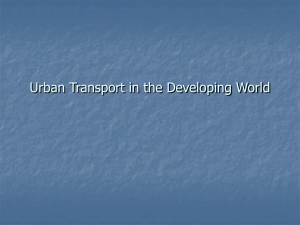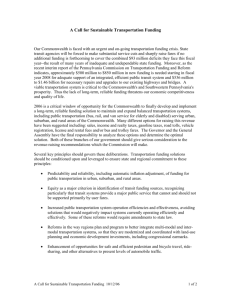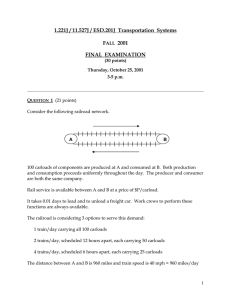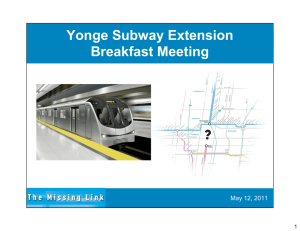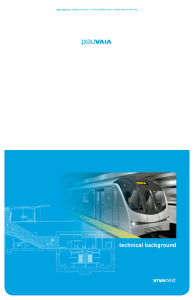English 180, Third Place; Professor, Barbara Ashwood Breanna Davis
advertisement
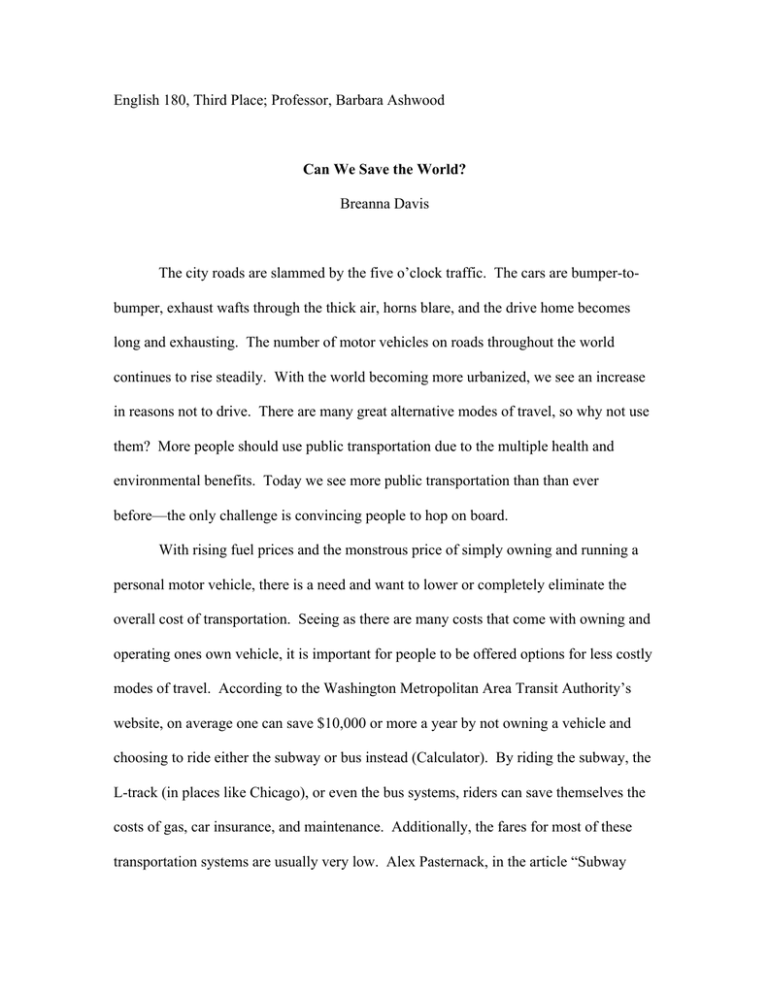
English 180, Third Place; Professor, Barbara Ashwood Can We Save the World? Breanna Davis The city roads are slammed by the five o’clock traffic. The cars are bumper-tobumper, exhaust wafts through the thick air, horns blare, and the drive home becomes long and exhausting. The number of motor vehicles on roads throughout the world continues to rise steadily. With the world becoming more urbanized, we see an increase in reasons not to drive. There are many great alternative modes of travel, so why not use them? More people should use public transportation due to the multiple health and environmental benefits. Today we see more public transportation than than ever before—the only challenge is convincing people to hop on board. With rising fuel prices and the monstrous price of simply owning and running a personal motor vehicle, there is a need and want to lower or completely eliminate the overall cost of transportation. Seeing as there are many costs that come with owning and operating ones own vehicle, it is important for people to be offered options for less costly modes of travel. According to the Washington Metropolitan Area Transit Authority’s website, on average one can save $10,000 or more a year by not owning a vehicle and choosing to ride either the subway or bus instead (Calculator). By riding the subway, the L-track (in places like Chicago), or even the bus systems, riders can save themselves the costs of gas, car insurance, and maintenance. Additionally, the fares for most of these transportation systems are usually very low. Alex Pasternack, in the article “Subway Fares Around the World,” explains that fares can cost anywhere from fifteen cents to five dollars depending on where the subway is located in the world and how many passengers ride on average (Pasternack). Some systems offer cards for one flat fee per month or year that allow riders to use the system for that given amount of time before they have to pay again. With all these money saving options, why not use public transportation systems? We need to inform others about the great benefits, and then surely other people will want to ride too. A challenge for increasing the use of public transportation is a lack of accessibility throughout the entire country. Many cities have systems that run throughout the city but not any systems or stops in or near the suburbs. Some people might argue that even though there are a lot of money saving benefits, putting these systems into more communities will just cost too much. However, the cost of making public transportation options available in more communities will eventually be paid back in full. In “Public Transportation Should Be a Priority For Every Government,” Lilani Goonesea finds that over 83% of Australians drive to and from work. She also finds that one in ten people use the already accessible systems, while the rest say that they do not have readily available systems (Goonesea). Through this information, we can assume that people are more than willing to use public transportation—they actually want it. With railways saving time and money for members of the community, people will be very willing to pay the price of the ticket to get to and from work every day. With so many people using the systems, the people will eventually pay for the construction costs. Another benefit of putting one of these systems into use is that it will overall help the community. These systems provide a better mode of transportation while also giving back. The money that is spent on the tickets for these systems goes back to the owners. Since most likely the city will own the system, the profits will go back to the city and can be reinvested in its infrastructure. The community could really benefit from a system like the railway, and the people clearly want to use it. Why have we not yet invested in more systems like this? Not only does using the subway or other public systems save riders money and positively contribute to the community, these systems also create a healthier community. Every day people drive their own motor vehicles to work, and each one of these cars puts out harmful fumes. According to McCubbin and Delucchi in the Journal of Public Transportation, the amount of CO2 emitted into the air can cause many health issues, including but not limited to asthma, chronic migraines, and cancer due to daily exposure. As the authors explain, “Motor vehicles emit a wide range of toxic compounds, which can be acutely or chronically poisonous, carcinogenic, teratogenic, or mutagenic” (264). The author goes on to tell readers about the specific effects of carbon monoxide and conclude that exposure to the compounds released by vehicles increases the risk of death (275). The thought of that is simply horrific. By lessening the amount of CO2 we put into the air through widespread use of pubic transit, we lessen the risk of harmful health effects. Another way that public transportation systems help to create a healthier community is by getting people to interact and move around. According to Shobha Srinivasan, Liam R. O’Fallon, and Allen Dearry in their article “Creating Healthy Communities, Healthy Homes, Healthy People: Initiating a Research Agenda on the Built Environment and Public Health,” driving a car to and from work alone everyday creates a sedentary and isolated lifestyle (1447). When people ride on public transportation systems, they have more opportunities to be interactive. Talking to other people on a daily basis can make one happier, which will in turn encourage better health. In his article “6 Health Benefits of Public Transportation,” John Mickey goes on to argue that public transit reduces passengers’ stress levels due to easy access to places that otherwise could not be reached (Mickey). In addition to these emotional advantages, public transit is physically beneficial. Chronic backaches and headaches can be caused by the stationary upright position required to drive a car every day. By moving around on the public transit commute, riders stop their bodies from being stuck in a stationary position and therefore lessen or completely eliminate these problems. Public transit’s ability to reduce pollution and increase interactivity and body motion can create a better community with healthier members. Our health is not the only factor affected by pollution: the environment around us is affected, too. The amount of CO2 and other toxins realized by motor vehicles continues to rise daily. These polluting toxins create a terrible environment for all living creatures by ruining habitats for plants and animals. According to the World Wildlife Fund’s website, humans have caused the natural extinction rate to be between 1,000 and 10,000 times higher than normal. Every year anywhere from 200 to 2,000 species go extinct (How Many Species). Without humans, this number would be significantly lower. Many people spend a significant amount of money to protect animals that are currently endangered. Little do these people know that simply cutting down on the use of motor vehicles can help a great deal. If we reduce the number of motor vehicles, we reduce the amount of polluting fumes and therefore increase the lifespan of many specifics. Not only are we polluting the environment with vehicle fumes, we also use non-renewable fossil fuels for our oil and gases. People are constantly drilling for oil and digging into the ground to find these precious substances. According to Ecotricity, Britain’s leading green energy supplier, if we continue to use fossil fuels at our current rate, they will be gone by the year 2052 (The End Of). As one can see, our planet will not have these useful resources someday—if we have a way to cut down on the use and conserve these resources, why not do it? We all know that these resources are vital to our daily life, but there are also many other renewable resources that can work well. It is our job to continue the research on these other means of energy while reducing the amount of fossil fuels we use through public transit. If we reduce the amount of toxins in the air and slow the rate of fossil fuel usage, we could change the world for the better. As one can see, putting public transportation systems into use could be the answer to many of the problems out world is currently facing. Many people are already very willing to use public transportation systems—maybe all the others could be persuaded to use them after learning of the benefits that come with riding these systems. Every year we see more problems in our global environment and the global economy. Our world is only going to face more difficult obstacles in the future, and unless we change our behaviors, the situation will only get worse. We have to be willing to take the first steps to make the world a better place, and increased public transportation is a way to do that. Public transit will lessen the current rate of motor vehicle use and in turn make the environment a safer and more livable place. Passengers who use public transit will save money and start living healthier lives. With all of these great benefits, why not use these great systems? Driving has so many cons that it does not even seem worth it to drive. Why don’t we all work together to stride into the future as a better generation? Works Cited “Calculator.” Washington Metropolitan Area Transit Authority. Web. 23 Apr. 2014. <www.wmata.com/rider_tools/calculator/calculator.cfm> Goonesa, Lilian. “Public Transportation Should Be a Priority For Every Government.” SBS News. 1 Apr. 2014. Web. 8 Apr. 2014. , <http://www.sbs.com.au/news/article/2014/04/01/comment-public-transportshould-be-priority-every-government> “How Many Species Are We Losing?” WWF. Web. 23 Apr. 2014. <http://wwf.panda.org/about_our_earth/biodiversity/biodiversity/> McCubbin, Donald R. and Mark A. Delucchi. “The Health Costs of Motor-VehicleRelated Air Pollution.” Journal of Transportation and Policy 33.3 (September 1999): 253-267. Mickey, John. “6 Health Benefits of Public Transportation.” Transloc. Web. 29 April. 2014. <http://transloc.com/6-health-benefits-of-public-transportation/> Pasternack, Alex. “Subway Fares Around the World.” Treehugger. Web. 23 April 2014. <http://www.treehugger.com/cars/subway-fares-around-the-world.html> Srinivasan, Shobha, Liam R. O’Fallon, and Allen Dearry. “Creating Healthy Communities, Healthy Homes, Healthy People: Initiating a Research Agenda on the Built Environment and Public Health.” American Journal of Public Health 93.9 (September 2003): 1446-1450. “The End of Fossil Fuels.” Ecotricity. Web. 28 April 2014. <https://www.ecotricity.co.uk/our-green-energy/energy-independence/the-end-offossil-fuels>
